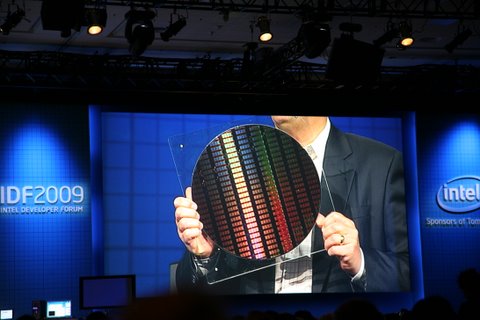32nm and 22nm

"We've begun production of the world's first 32nm microprocessor, which is also the first high-performance processor to integrate graphics with the CPU. At the same time, we're already moving ahead with development of our 22nm manufacturing technology and have built working chips that will pave the way for production of still-more-powerful and more-capable processors," he said.
To prove his point, and perhaps also to wake up the audience, the Intel boss showed off the first 22nm SRAM wafer, declaring "At Intel, Moore's Law is alive and thriving." The 22nm wafer Otellini waved about was purportedly made up of individual die containing 364 million bits of SRAM memory, with over 2.9 billion transistors packed into an area the size of a fingernail. The chips apparently contain the smallest SRAM cell used in working circuits ever reported at .092 square microns and the devices rely on third-generation high-k metal-gate transistor technology for better performance and lower leakage power. Despite the optimism, however, questions still remain whether it will be possible, and indeed viable, to go much beyond the 22nm process.
Otellini also discussed future generations of Atom architecture, Bonnell based on a 45nm process and Saltwell based on 32nm, as well as plans for future generations at 22nm and 15nm, so, much like its Itanium architecture, it seems Intel is stuck with Atom for the foreseeable future, whether it wants to be or not.
Discussing its recently announcedTSMC partnership, Otellini was also quick to point out Intel wasn't using the Taiwanese fab firm for capacity reasons (or lack thereof) but rather as a way of reaching out to new customers.
System-on-a-chip
Otellini said Intel would be taking advantage of its silicon scaling capabilities to achieve ultra low power, and emphasised that no less than 12 new 32nm SOCs were already in production. Intel will also be looking towards shipping more SoC processors per year than microprocessors, according to the CEO.
Giving a nod to Intel's new branding scheme, which had initially caused some confusion, Otellini promised the firm would now be consistent with it "for a long time," which should come as a relief to both befuddled customers and OEMs alike.
Software and security
Moving on to discuss software, Otellini entered ‘buzz word' territory, claiming it was now all about "multiple clients and multiple clouds", re-iterating how very committed Intel was to its developer community and offering " 1st class support to developers." He also claimed to be "very excited about windows 7" which he said would be a "much better platform power management" that would help preserve battery life.
Demoing some new and improved vPro security features on a 32nm Westmere-based laptop, Otellini said his firm wanted "to allow security to be done in a very transparent fashion." Last year, Intel demoed an anti-theft feature which allowed users to disable their platform by sending a data "kill pill" to the machine via the net. This year, Intel has taken things a step farther, allowing a user to not only disable the platform, but also the hard drive, which can, of course be reactivated by its rightful owner with the click of a button.
Next up came the only genuinely "new" part of the entire presentation, as the audience was treated to a digital media demo on next-generation silicon, Sandy Bridge, for first time.









